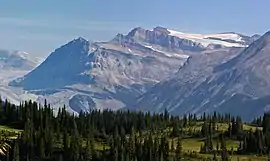Mount Gordon (Canada)
Mount Gordon is a 3,161-metre (10,371-foot) mountain summit located immediately west of the Continental Divide, in the Waputik Range of the Canadian Rockies in British Columbia, Canada.[1] It is a glaciated dome situated in Yoho National Park, and is the highest point of the Wapta Icefield. Its nearest higher peak is Mount Baker, 8.8 km (5.5 mi) to the northwest.[1]
| Mount Gordon | |
|---|---|
 Mount Gordon seen from Iceline Trail | |
| Highest point | |
| Elevation | 3,161 m (10,371 ft) [1] |
| Prominence | 471 m (1,545 ft) [1] |
| Listing | Mountains of British Columbia |
| Coordinates | 51°36′22″N 116°30′48″W [2] |
| Geography | |
 Mount Gordon Location of Mount Gordon in British Columbia  Mount Gordon Mount Gordon (Canada) | |
| Location | Yoho National Park British Columbia, Canada |
| Parent range | Waputik Range Canadian Rockies |
| Topo map | NTS 82N/10[2] |
| Geology | |
| Age of rock | Cambrian |
| Type of rock | Sedimentary |
| Climbing | |
| First ascent | 1897 G. Baker, J.N. Collie, H.B. Dixon, C.E. Fay, A. Michael, C.L. Noyes, H.C. Parker, C.S. Thompson, P.Sarbach |
History
The first ascent of the mountain was made in August 1897 by George Percival Baker, J. Norman Collie, H. B. Dixon, Charles Ernest Fay, Arthur Michael, C. L. Noyes, H. C. Parker, and Charles Sproull Thompson, with Peter Sarbach as guide.[1]
The mountain was named in 1897 by Charles Sproull Thompson of the first ascent party for John Hamilton-Gordon, 1st Marquess of Aberdeen and Temair, at the time Governor General of Canada from 1893 to 1898.[3] After descending from the summit of Mount Gordon, Thompson fell into a crevasse and became lodged which required rescue by the team.[4] Mount Thompson, six kilometres to the north of Mount Gordon, was one of several peaks named by this same climbing party.
The mountain's name was officially adopted in 1924 when approved by the Geographical Names Board of Canada.[2]
Geology
Mount Gordon is composed of sedimentary rock laid down during the Precambrian to Jurassic periods.[5] Formed in shallow seas, this sedimentary rock was pushed east and over the top of younger rock during the Laramide orogeny.[6]
Climate
Based on the Köppen climate classification, Mount Gordon is located in a subarctic climate zone with cold, snowy winters, and mild summers.[7] Temperatures can drop below −20 °C with wind chill factors below −30 °C.
References
- "Mount Gordon". Bivouac.com. Retrieved 2019-03-21.
- "Mount Gordon". Geographical Names Data Base. Natural Resources Canada. Retrieved 2019-03-21.
- "Mount Gordon". BC Geographical Names. Retrieved 2019-10-28.
- "Mount Gordon". PeakFinder.com. Retrieved 2019-10-28.
- Belyea, Helen R. (1960). The Story of the Mountains in Banff National Park (PDF). parkscanadahistory.com (Report). Ottawa: Geological Survey of Canada. Archived (PDF) from the original on 2015-10-02. Retrieved 2019-09-13.
- Gadd, Ben (2008). Geology of the Rocky Mountains and Columbias.
- Peel, M. C.; Finlayson, B. L. & McMahon, T. A. (2007). "Updated world map of the Köppen−Geiger climate classification". Hydrol. Earth Syst. Sci. 11: 1633–1644. ISSN 1027-5606.
External links
- Weather forecast: Mount Gordon